-
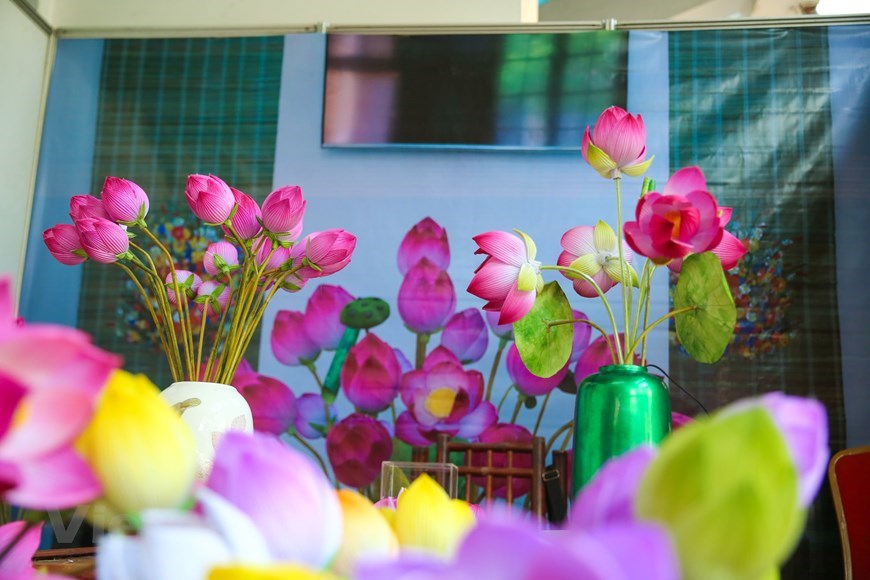
Lotus flowers made of paper by artisans in Thanh Tien village. Lying downstream of the Huong (Perfume) River in Phu Mau commune, Phu Vang district, the Thanh Tien paper flower making village is 7 km away from the ancient imperial city of Hue and has a history spanning some 300 years. It was recognised by the Thua Thien – Hue province as a traditional craft village in 2013, with local products displayed at many cultural festivals, including Hue festivals and Ao Dai (Vietnamese traditional long dress) festivals as well as exported to many countries. Every year, in the run-up to Tet (Vietnamese Lunar New Year Festival), the village seems to be wearing a “new shirt” of vibrant colours from its paper flowers. (Photo: VietnamPlus)
-
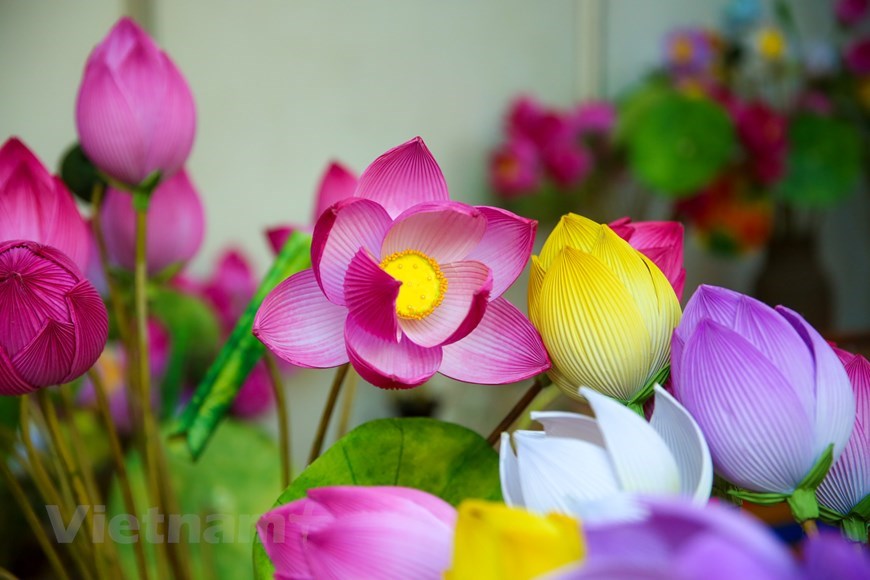
Making paper lotus flower requires the most intricate craftsmanship, with only three out of ten households practicing the craft capable of producing the sophisticated products. Local artisan Than Van Huy said Thanh Tien paper lotus has been present in many countries like the US, Japan and the Republic of Korea. He added that various contracts have been signed since the village joined the Hue Traditional Craft Festival for the first time in 2013. Organised biennially by the Hue City People’s Committee, the festival honours the value of heritage and raises the quality of traditional trade villages, and helped Vietnamese handicraft products reach out to the world. (Photo: VietnamPlus)
-
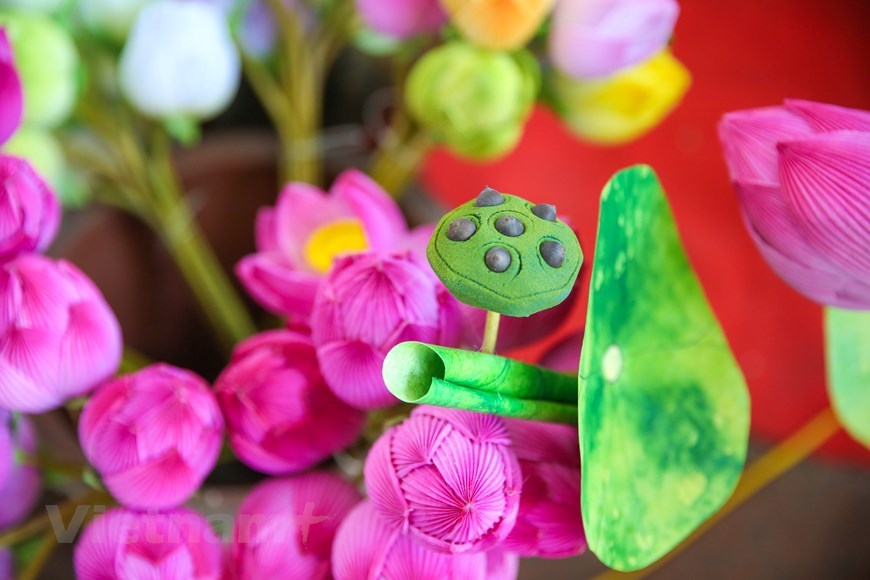
The most challenging steps in making paper lotus flowers are creating veins for the petals and assembling the petals, according to local artisans. There are two months left until the Lunar New Year Festival, meaning the village, 7 km away from the ancient imperial city of Hue, is bustling in preparing their products serving the market near and far. Having a history spanning some 300 years, it was recognised by the Thua Thien – Hue province as a traditional craft village in 2013, with local products displayed at many cultural festivals, including Hue festivals and Ao Dai (Vietnamese traditional long dress) festivals as well as exported to many countries. (Photo: VNA)
-
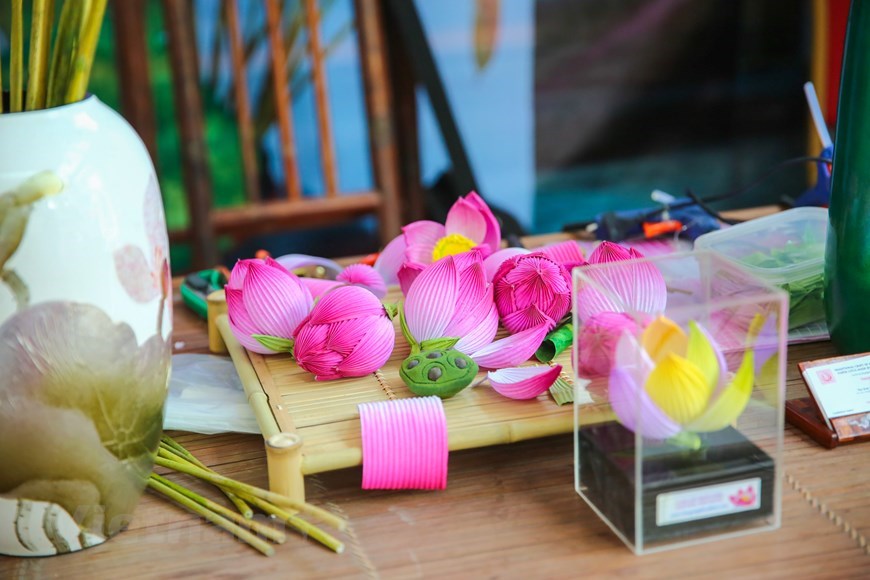
During these days ahead of the Lunar New Year Festival (Tet), visitors to the 300-year-old village can clearly feel the bustling atmosphere of buyers and sellers. Every year, in the run-up to Tet, Thanh Tien seems to be wearing a “new shirt” of vibrant colours from its paper flowers. Currently, there are about 10 households in the village still retaining the traditional techniques of making paper flowers by hand. The craft has been practiced as part of the Hue people’s ancestor worship. As the local climate is hot and sunny in the dry season, and humid and rainy in the wet season, it is hard for real flowers to remain fresh on their ancestors’ altars, hence the demand for the paper-made alternatives. (Photo: VietnamPlus)
-
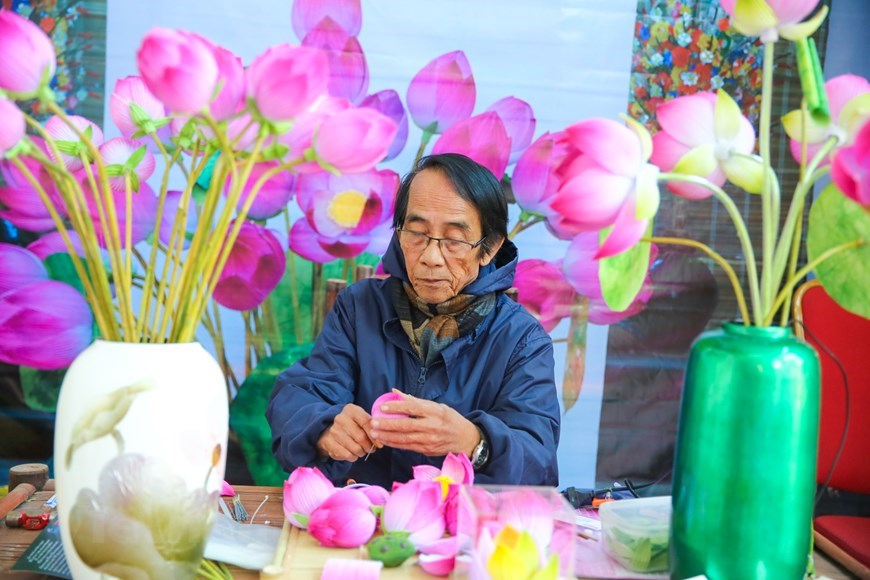
Local artisan Than Van Huy, who has more than 50 years of experience in making paper flowers, said that right from the seventh month of the lunar calendar, he has prepared enough materials for his work serving the needs of customers during Tet (Vietnamese Lunar New Year Festival). In the past, Thanh Tien villagers made paper flowers as an offering to their ancestors and gods. Nowadays, their products are also decorative items, particularly on the occasion of Tet. Lying downstream of the Huong (Perfume) River in Phu Mau commune, Phu Vang district, the paper flower making village has a history spanning some 300 years. It was recognised by Thua Thien – Hue province as a traditional craft village in 2013. (Photo: VietnamPlus)
-
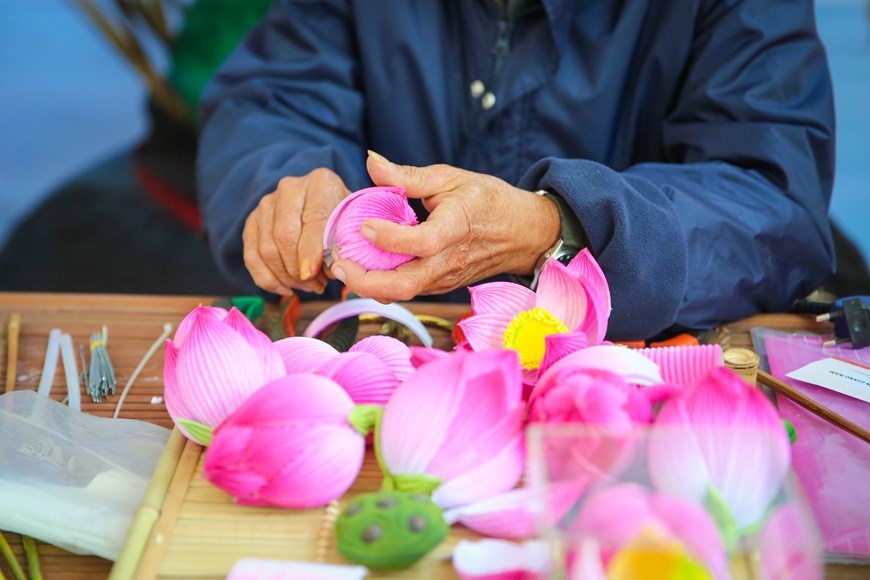
Local artisan Than Van Huy, who has been practiced the craftsmanship for more than 50 years, is creating lotus flowers from paper. Making paper lotus flowers requires the most intricate craftsmanship, with only three out of ten households practicing the craft capable of producing the sophisticated products. The most challenging steps are creating veins for the lotus petals and assembling them, according to local artisans. Huy said Thanh Tien paper lotus has been present in many countries like the US, Japan and the Republic of Korea. He added that various contracts have been signed since the village joined the Hue Traditional Craft Festival for the first time in 2013. (Photo: VietnamPlus)
-
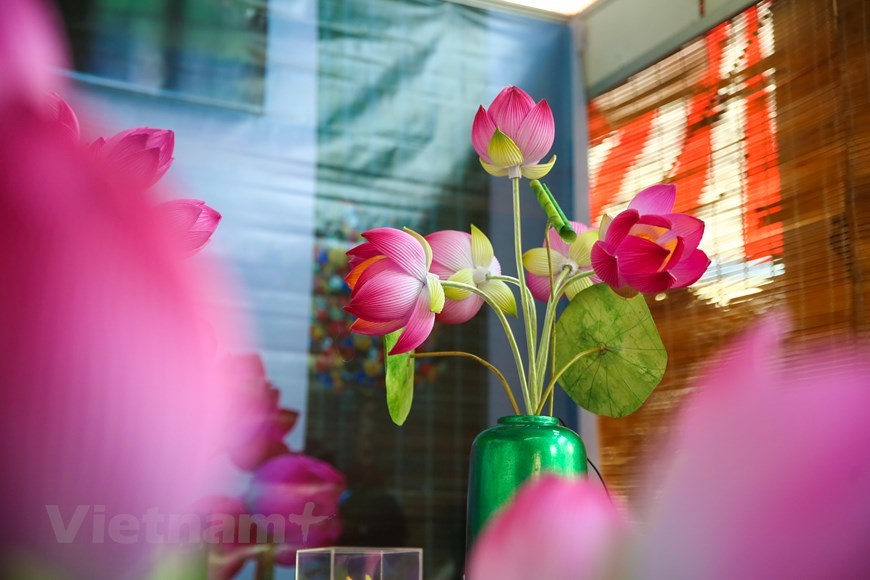
Thanh Tien is a village with a long history that has been preserved and developed for more than 300 years. It was recognised by Thua Thien – Hue province as a traditional craft village in 2013, with local products displayed at many cultural festivals, including Hue festivals and Ao Dai (Vietnamese traditional long dress) festivals as well as exported to many countries. Thanh Tien’s paper flower making craft was originated from folk beliefs. According to the old custom, the flowers are used to decorate solemn places such as shrines and pagodas. Once a year on the occasion of the Lunar New Year Festival, people buy new flowers to replace the old ones, which are taken down and burned. (Photo: VietnamPlus)
-
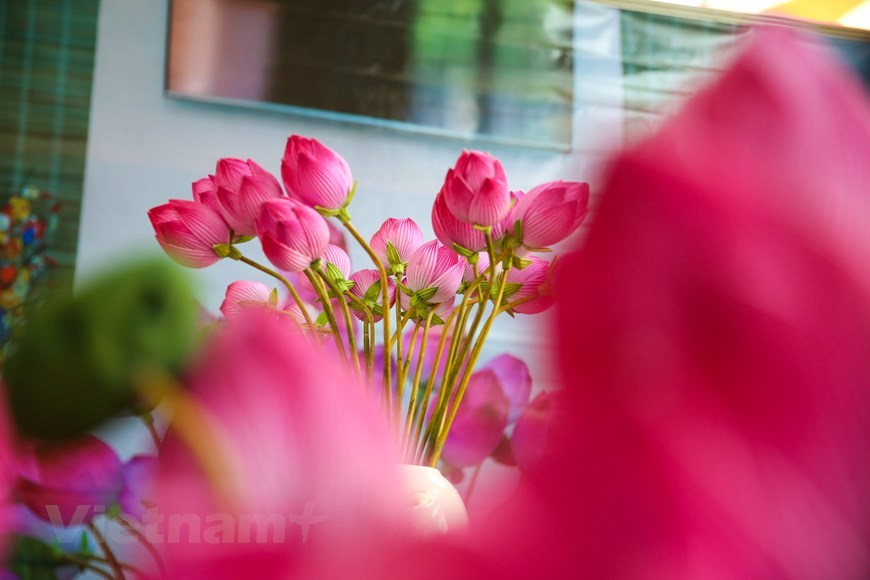
The Thanh Tien paper flower craft village is stiuated downstream of the Huong (Perfume) River in Phu Mau commune, Phu Vang district, which is 7 km away from the ancient imperial city of Hue. Thanh Tien’s paper flower making craft was originated from folk beliefs. According to the old custom, the flowers are used to decorate solemn places such as shrines and pagodas. Once a year on the occasion of the Lunar New Year Festival, people buy new flowers to replace the old ones, which are taken down and burned. Thanh Tien’s artisans make two main types of flowers – those colourful ones for worshipping purposes and lotus with the colour of romantic purple, which characterise Hue city. (Photo: VietnamPlus)
-
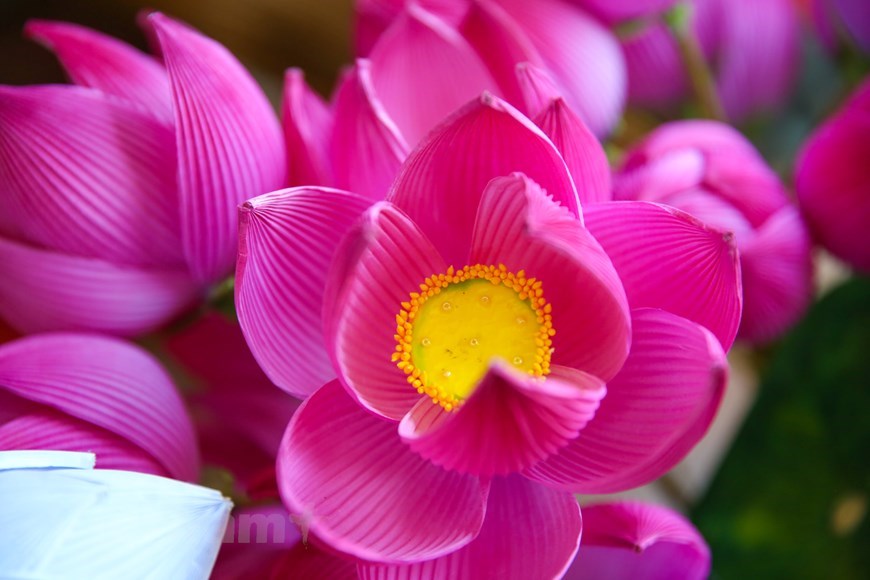
The 300 years old Thanh Tien village is famous for its paper flower making craft. Local artisans make two main types of flowers – those colourful ones for worshipping purposes and lotus with the colour of romantic purple, which characterise Hue city. Currently, there are about 10 households in the village still sustaining the traditional techniques of making paper flowers by hand. The craft has been practiced as part of the Hue people’s ancestor worship, with all steps done manually. Thanh Tien village in Phu Mau commune, Phu Vang district was recognised by Thua Thien – Hue province as a traditional craft village in 2013. (Photo: VietnamPlus)
-

The paper flowers are popular among local people particularly for worshipping purposes. They are used to decorate solemn places such as shrines and pagodas. Following the old custom, once a year on the occasion of the Lunar New Year Festival, people buy new flowers to replace the old ones, which are taken down and burned. Local artisan Than Van Huy, who has more than 50 years of experience in making paper flowers, said that right from the seventh month of the lunar calendar, he has prepared enough materials for his work serving the needs of customers during Tet (Vietnamese Lunar New Year festival). (Photo: VietnamPlus)
-
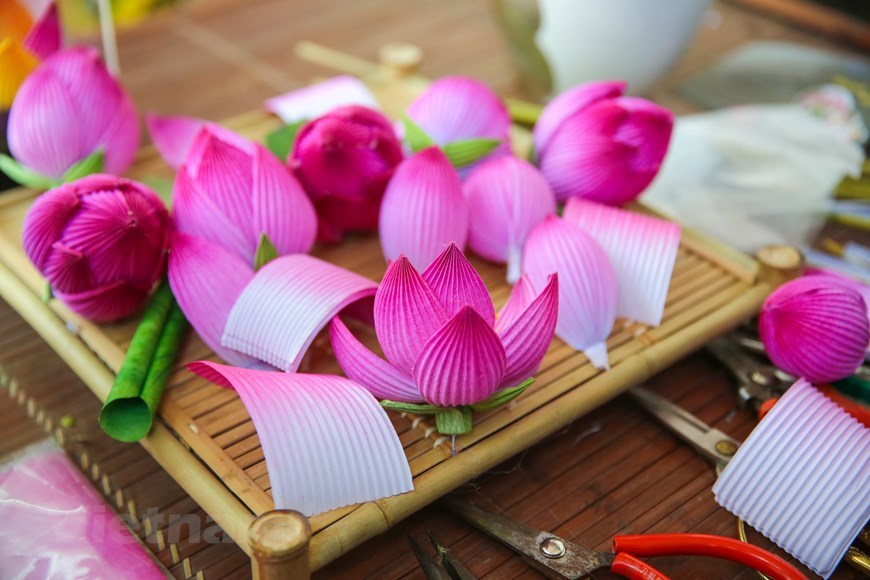
Thanh Tien village’s paper flower making craft was originated from folk beliefs. According to the old custom, the flowers are used to decorate solemn places such as shrines and pagodas. Once a year on the occasion of the Lunar New Year Festival, people buy new flowers to replace the old ones, which are taken down and burned. Lying downstream of the Huong (Perfume) River in Phu Mau commune, Phu Vang district, the paper flower making village is 7 km away from the ancient imperial city of Hue and has a history spanning some 300 years. Currently, there are about 10 households in the village still sustaining the traditional techniques of making paper flowers by hand. (Photo: VietnamPlus)
-

Once a year on the occasion of the Lunar New Year Festival, people buy new flowers to replace the old ones, which are taken down and burned. Thanh Tien village’s paper flower making craft was originated from folk beliefs. Thanh Tien’s artisans make two main types of flowers – those colourful ones for worshipping purposes and lotus with the colour of romantic purple, which characterise Hue city. According to the old custom, the flowers are used to decorate solemn places such as shrines and pagodas. As the local climate is hot and sunny in the dry season and humid and rainy in the wet season, it is hard for real flowers to remain fresh on their ancestors’ altars, hence the demand for the paper-made alternatives. (Photo: VietnamPlus)
-
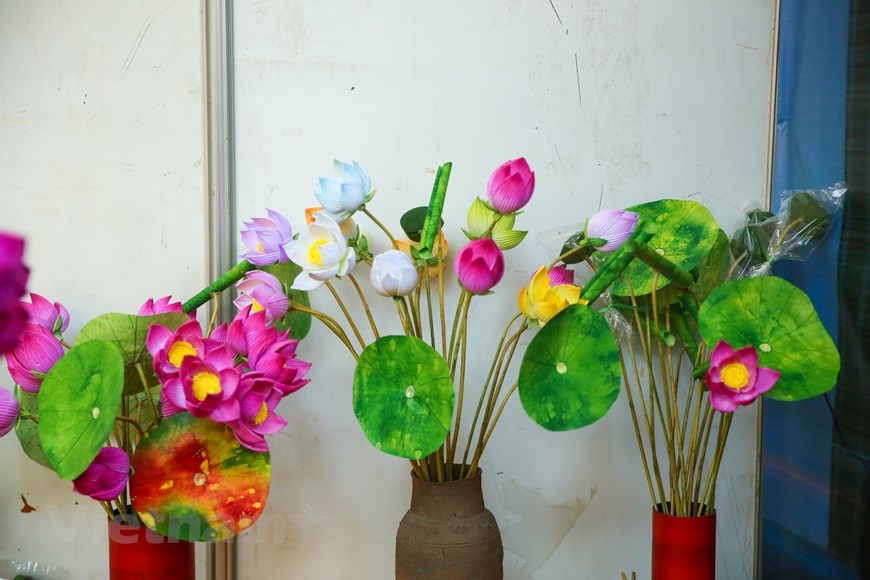
As time goes by, Thanh Tien’s paper flowers have become part of Hue people’s culture and beliefs. The paper flowers serve worshipping purposes, and also carry aesthetic and cultural values. Currently, the demand for worshiping paper flowers has decreased significantly, but the local people still want to keep this craft village as a unique cultural feature of the province. The craft has long been practiced as part of the Hue people’s ancestor worship, with all steps done manually. Thanh Tien village in Phu Mau commune of Phu Vang district was recognised by Thua Thien – Hue province as a traditional craft village in 2013. (Photo: VietnamPlus)
-
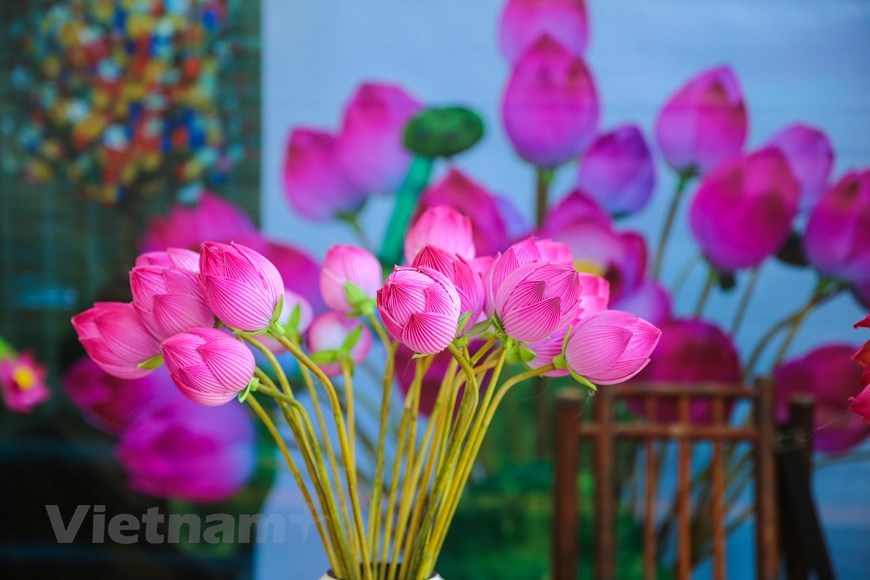
Currently, there are about 10 households in the village still sustaining the traditional techniques of making paper flowers by hand. Thanh Tien’s artisans make two main types of flowers – those colourful ones for worshipping purposes and lotus with the colour of romantic purple, which characterise Hue city. All steps in making the flowers are done manually and carefully over a significant period of time. Making paper lotus flower requires the most intricate craftsmanship, with only three out of the ten households capable of producing the sophisticated products. The most challenging steps in making paper lotus flowers are creating veins for the petals and assembling these petals, according to local artisans. (Photo: VietnamPlus)
-

All steps in making a paper flower in the 300-year-old Thanh Tien craft village are done manually and carefully over a significant period of time. Thanh Tien’s artisans make two main types of flowers – those colourful ones for worshipping purposes and lotus with the colour of romantic purple, which characterise Hue city. A skilled paper flower maker can produce 15 to 20 flowers per day. They are required to make their products resemble a variety of real flowers, including lotuses, roses, apricots, and orchids. Every year, in the run-up to Tet (Vietnamese Lunar New Year Festival), the village seems to be wearing a “new shirt” of vibrant colours from its paper flowers. (Photo: VietnamPlus)
-
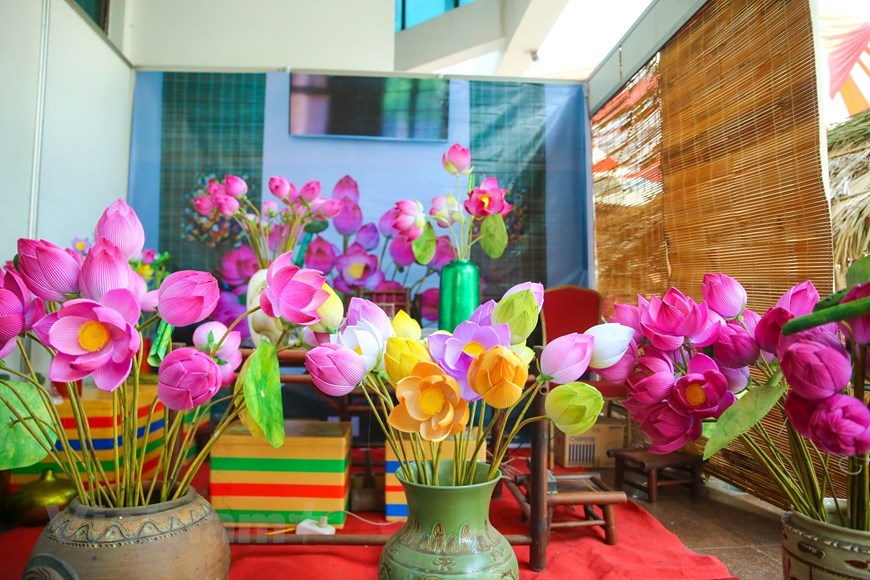
The making of a paper flower takes a lot of time and requires the maker to have meticulousness and skillful hands. A skilled paper flower maker can produce from 15 to 20 flowers per day. They are required to make their products resemble a variety of real flowers, including lotuses, roses, apricots, and orchids. As Tet (Vietnamese Lunar New Year Festival) approaches, their job gets busier to ensure an adequate supply of the flowers that do not wither. In the final step, the flowers are stuck into straw-wrapped stumps, with each stump carrying 100 flowers. The sellers will carry the flower stick on his shoulder to walk around the streets to meet their customers. (Photo: VietnamPlus)
-
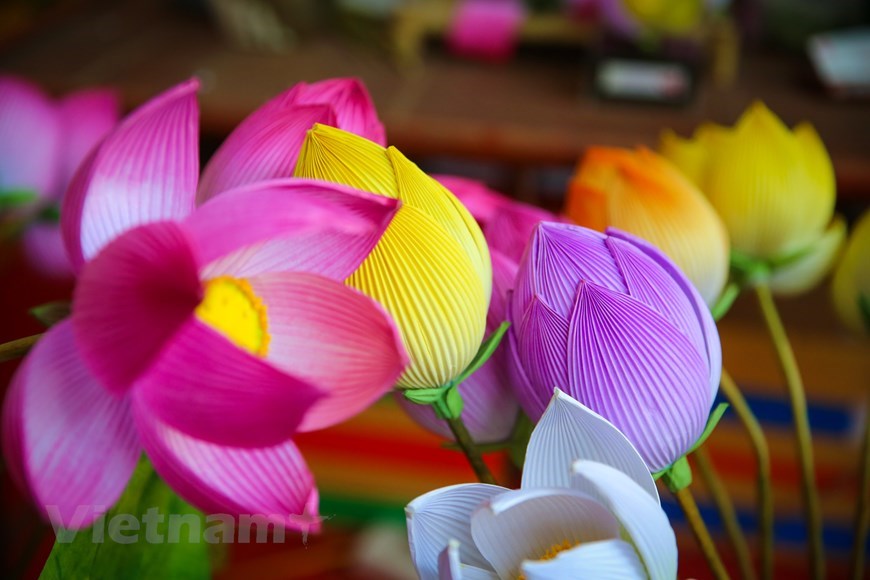
All details of Thanh Tien’s handmade paper flowers are carefully prepared by local artisans. The making of a paper flower takes a lot of time and requires the maker to have meticulousness and skillful hands. A skilled paper flower maker can produce from 15 to 20 flowers per day. They are required to make their products resemble a variety of real flowers, including lotuses, roses, apricots, and orchids. First, the craftsmen must carefully select bamboo to be dried and sliced in order to make the pedicles and branches of the flowers. Then they dye paper to create the petals, using natural colours extracted from local plants and without any chemicals. (Photo: VietnamPlus)
-
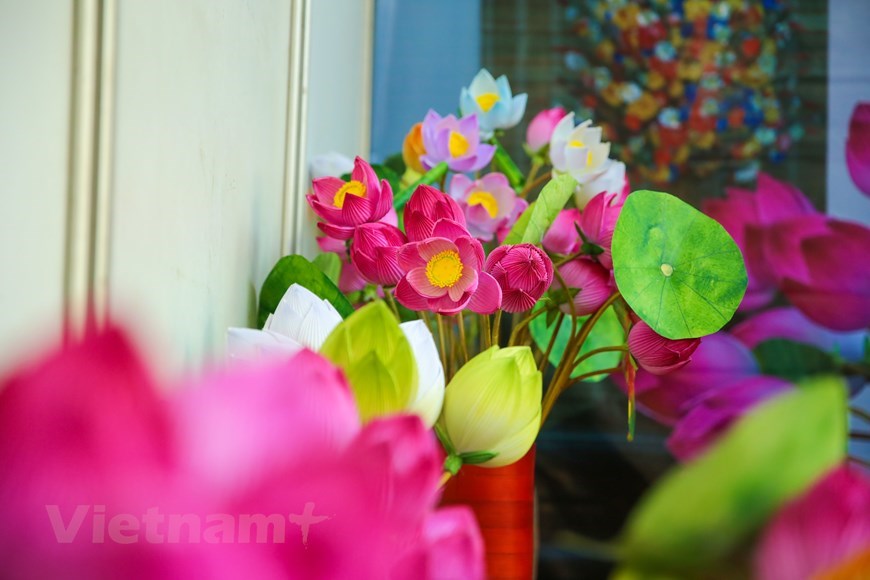
First of all, craftsmen in Thanh Tien carefully select bamboo to be dried and sliced in order to make the pedicles and branches of the flowers. Then they dye paper to create the petals, using natural colours extracted from local plants and without any chemicals. Cassava intestine is used to make the pistils. All these parts are fused into a complete flower. Attaching the flowers to their branches is also an interesting thing, as each branch usually has from 9 to 10 flowers, which are locally considered lucky numbers that always bring good things. A skilled paper flower maker can produce from 15 to 20 flowers per day. (Photo: VietnamPlus)
-

In the final step, the flowers are stuck into straw-wrapped stumps, with each stump carrying 100 flowers. The sellers will carry the flower sticks on his shoulder to walk around streets to look for customers. Going through a painstaking process that requires a lot of time and fine craftsmanship, the flowers resemble a variety of real flowers, including lotuses, roses, apricots, and orchids. They serve worshipping purposes, and also carry aesthetic and cultural values. According to the old custom, the flowers are used to decorate solemn places such as shrines and pagodas. Once a year on the occasion of the Lunar New Year Festival, people buy new flowers to replace the old ones, which are taken down and burned. (Photo: VietnamPlus)
-
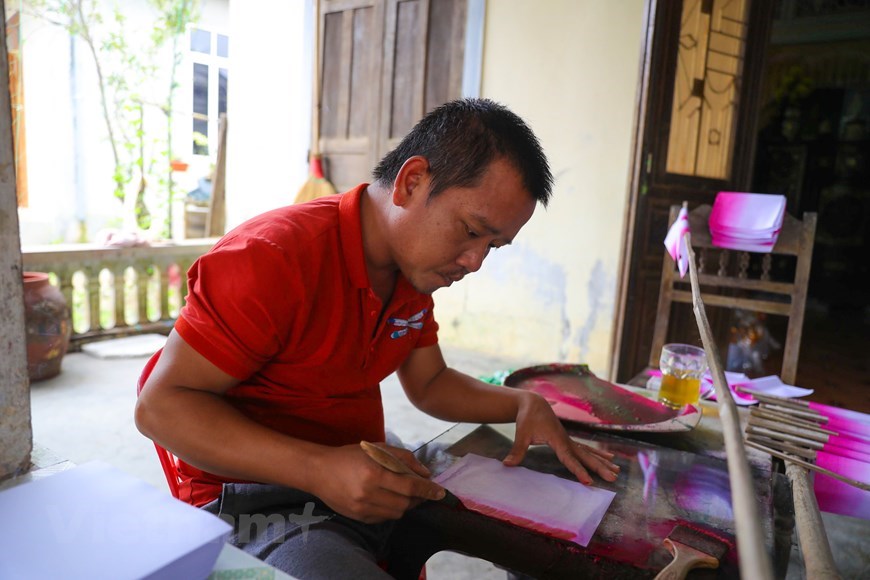
As Tet (Vietnamese Lunar New Year festival) approaches, local craftsmen get busier to ensure an adequate supply of their flowers that do not wither. All details of Thanh Tien’s handmade paper flowers are carefully prepared by local artisans. The making of a paper flower takes a lot of time and requires the maker to have meticulousness and skillful hands. A skilled paper flower maker can produce between 15 and 20 flowers per day. First, the craftsmen must carefully select bamboo to be dried and sliced in order to make the pedicles and branches of the flowers. Then they dye paper to create the petals, using natural colours extracted from local plants and without any chemicals. (Photo: VietnamPlus)
-
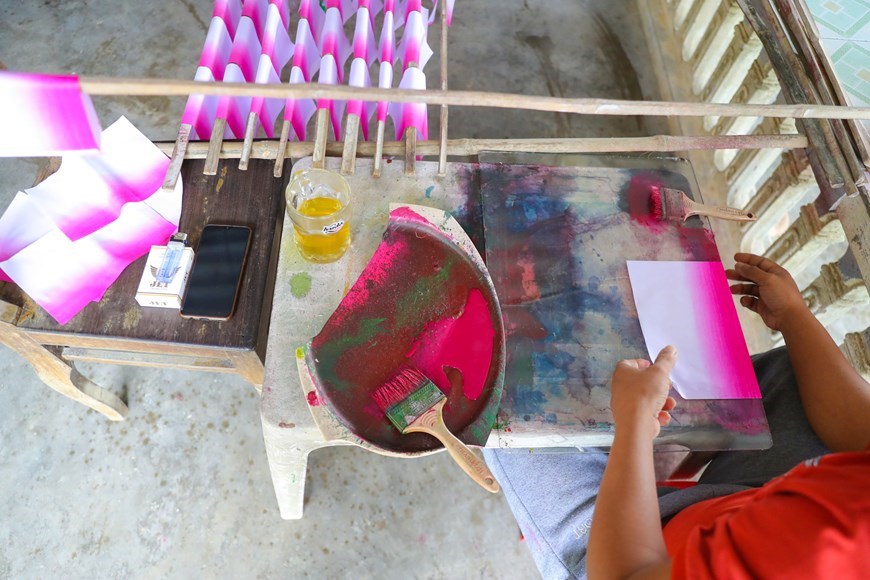
To make a petal, a local artisan ought to have skillful and meticulous hands. A petal making process sees bamboo whittled into thin sticks and dried; paper dyed; and the shapes of petals meticulously trimmed. After these parts are glued together, a flower branch is formed with harmonious colors and layout. Going through a painstaking process that requires a lot of time and fine craftsmanship, the flowers resemble a variety of real flowers, including lotuses, roses, apricots, and orchids. They serve worshipping purposes, and also carry aesthetic and cultural values. According to the old custom, the flowers are used to decorate solemn places such as shrines and pagodas. (Photo: VietnamPlus)
-
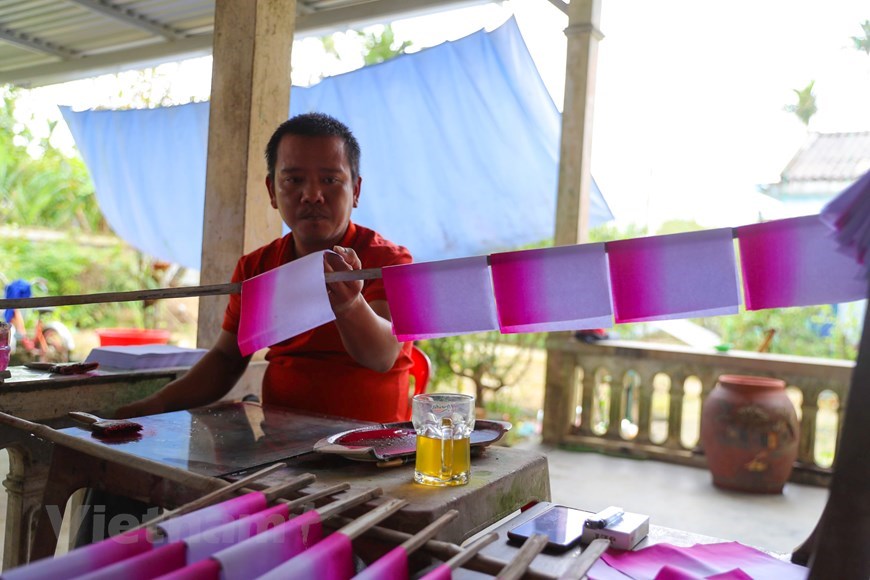
A skilled paper flower maker can produce between 15 and 20 flowers per day. First of all, craftsmen in Thanh Tien carefully select bamboo to be dried and sliced in order to make the pedicles and branches of the flowers. Then they dye paper to create the petals, using natural colours extracted from local plants and without any chemicals. Cassava intestine is used to make the pistils. All these parts are fused into a complete flower. Attaching the flowers to their branches is also an interesting thing, as each branch usually has from 9 to 10 flowers, which are locally considered lucky numbers. (Photo: VietnamPlus)
-
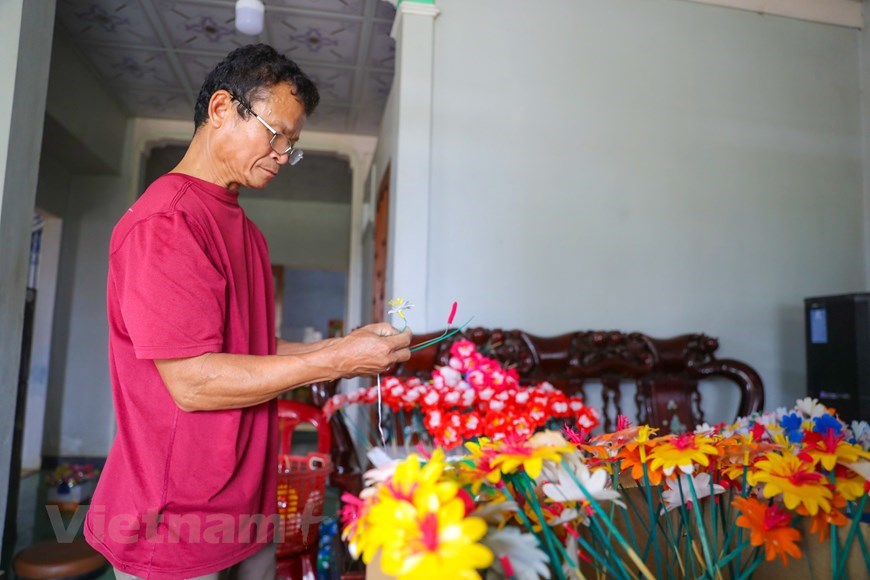
Nguyen Hoa, a local artisan who has more than four decades of experience in making paper flowers, said that on the occasion of Tet (Vietnamese Lunar New Year Festival), he and his family need to make about 2,000 pairs of flowers for worshipping in order to supply to the market. There are times when there is no one available to work during the peak season, flower-making families in Thanh Tien village even have to ask their neighbours to come and help to ensure their progress. Currently, there are about 10 households in the village still sustaining the traditional techniques of making paper flowers by hand. (Photo: VietnamPlus)
-
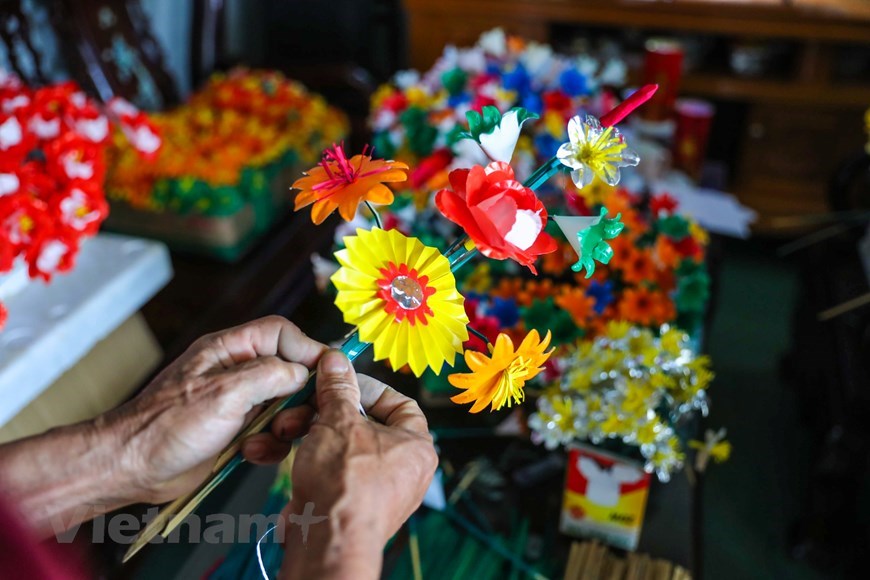
“We have to prepare all the materials from the 6th to the 7th lunar months, just in time to put them on the market. There are two main types of flowers produced in Thanh Tien – those for worshiping purposes, which are only supplied to the market during Tet (Vietnamese Lunar New Year Festival), and paper lotus flowers, which are supplied to the market all year round,” said local artisan Nguyen Hoa. Currently, there are about 10 households in the village still sustaining the traditional techniques of making paper flowers by hand. Just three of them are able to make lotus flowers, as the product requires the finest craftsmanship. (Photo: VietnamPlus)
-

Made from papers, Thanh Tien’s flowers resemble a variety of real flowers, including lotuses, roses, apricots, and orchids. A skilled paper flower maker can produce from 15 to 20 flowers per day. First of all, craftsmen in Thanh Tien carefully select bamboo to be dried and sliced in order to make the pedicles and branches of the flowers. Then they dye paper to create the petals, using natural colours extracted from local plants and without any chemicals. Cassava intestine is used to make the pistils. All these parts are fused together to make a complete flower. The making of a paper flower takes a lot of time and requires the maker to have meticulousness and skillful hands. (Photo: VietnamPlus)
-
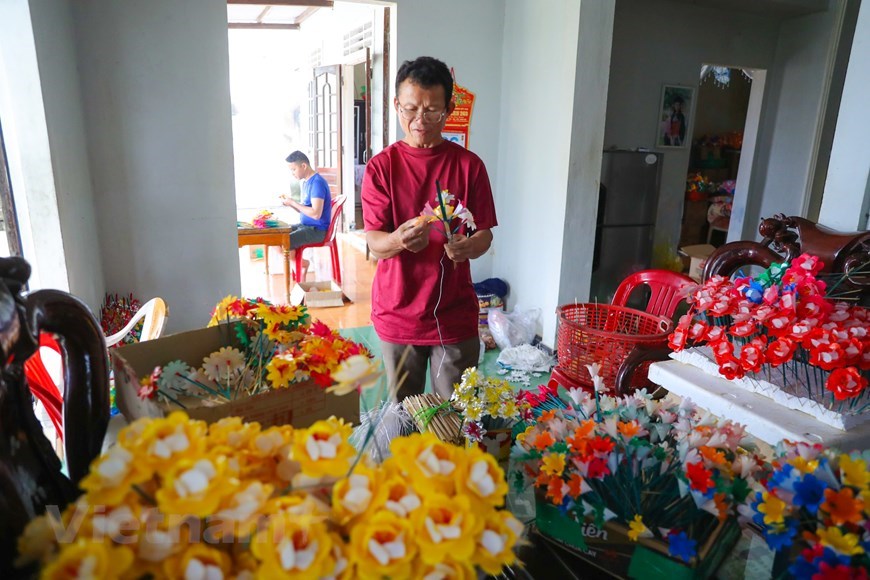
The hardest part of paper flower making is creating a final product that looks like a real flower, consisting of all parts of the flower like branches, leaves, buds, and stamens in a harmonious and gentle manner. All steps in making a paper flower in the 300-year-old Thanh Tien craft village are done manually and carefully in a significant period of time. Thanh Tien’s artisans make two main types of flowers – those colourful ones for worshipping purposes and lotuses with the colour of romantic purple, which characterise Hue city. A skilled paper flower maker can produce between 15 and 20 flowers per day. (Photo: VietnamPlus)
-
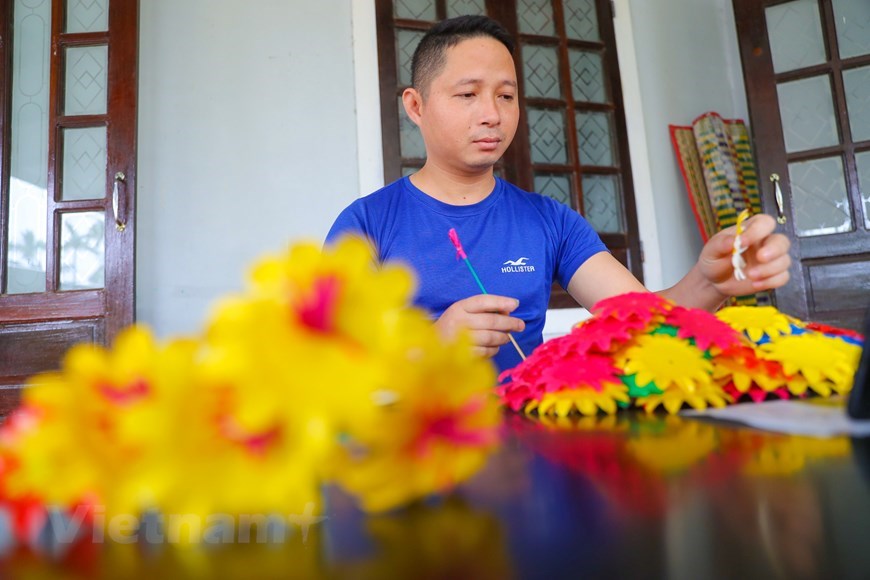
During the paper flower making process of artisans in Thanh Tien, attaching the flowers to their branches is an interesting part, as each branch usually has from 9 to 10 flowers, which are locally considered lucky numbers that always bring good things. Going through a painstaking process that requires a lot of time and fine craftsmanship, their paper flowers resemble a variety of real flowers, including lotuses, roses, apricots, and orchids. They serve worshipping purposes, and also carry aesthetic and cultural values. According to the old custom, the flowers are used to decorate solemn places such as shrines and pagodas. (Photo: VietnamPlus)
-
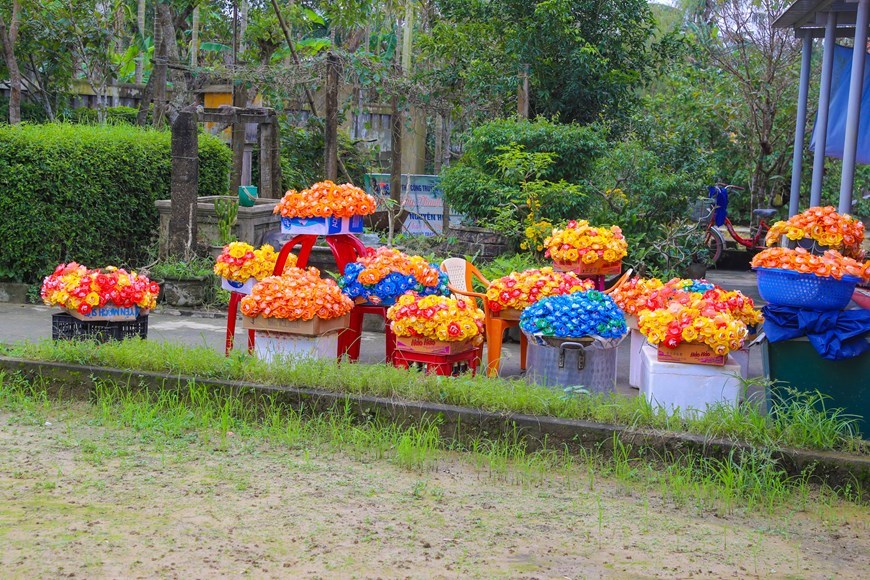
Local paper flower makers in the 300-year-old village jokingly said that they trade their labour for profits. All steps they go through at work are done manually and carefully in a significant period of time. Thanh Tien’s artisans make two main types of flowers – those colourful ones for worshipping purposes and lotuses with the colour of romantic purple, which characterise Hue city. A skilled paper flower maker can produce from 15 to 20 flowers per day. The price of the paper flowers ranges from 5,000 VND for a pair of simple flowers such as rose, daisy and orchid to 20,000 VND for a lotus. (Photo: VietnamPlus)
-
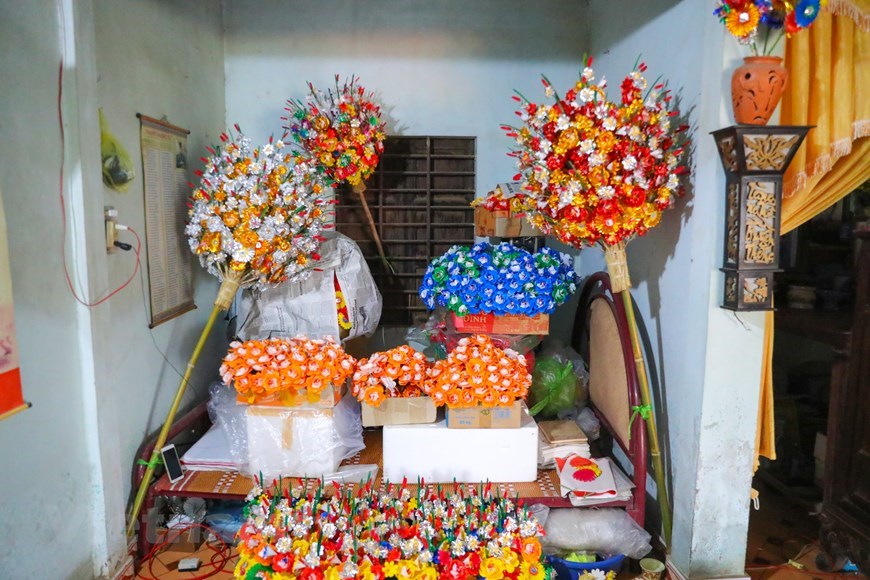
Going through a painstaking process that requires a lot of time and fine craftsmanship, the paper flowers serve worshipping purposes, and also carry aesthetic and cultural values. They resemble a variety of real flowers, including lotuses, roses, apricots, and orchids. According to the old custom, the flowers are used to decorate solemn places such as shrines and pagodas. Once a year on the occasion of the Lunar New Year Festival, people buy new flowers to replace the old ones, which are taken down and burned. As Tet (Vietnamese Lunar New Year Festival) approaches, local flower makers get busier to ensure an adequate supply to the market. (Photo: VietnamPlus)
-
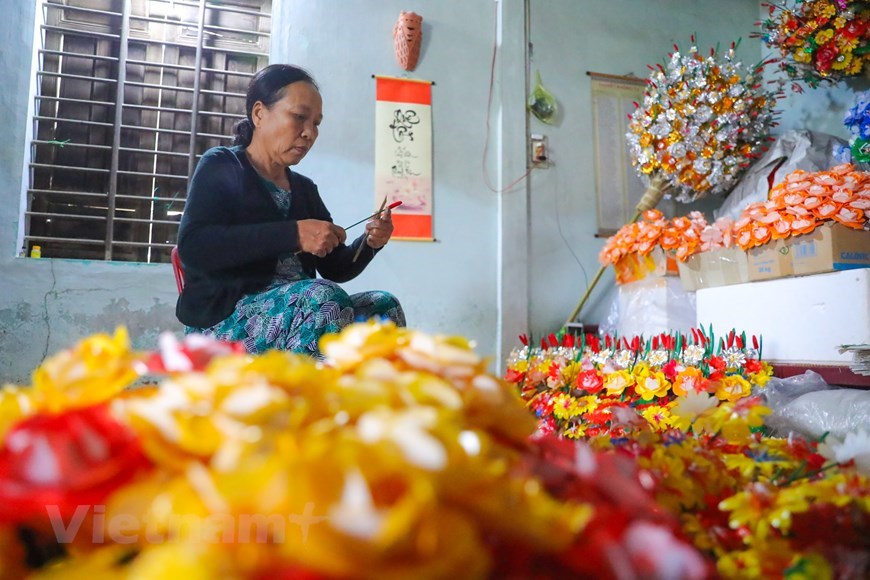
Currently, the demand for worshiping paper flowers has decreased significantly, but the local people still want to keep this craft village as a unique cultural feature of the province. The craft has long been practiced as part of the Hue people’s ancestor worship, with all steps done manually. There are about 10 households in the village still sustaining the traditional techniques of making paper flowers by hand. Just three of them are able to make lotus flowers, as the product requires the finest craftsmanship. Thanh Tien village in Phu Mau commune, Phu Vang district, was recognised by Thua Thien – Hue province as a traditional craft village in 2013. (Photo: VietnamPlus)
-
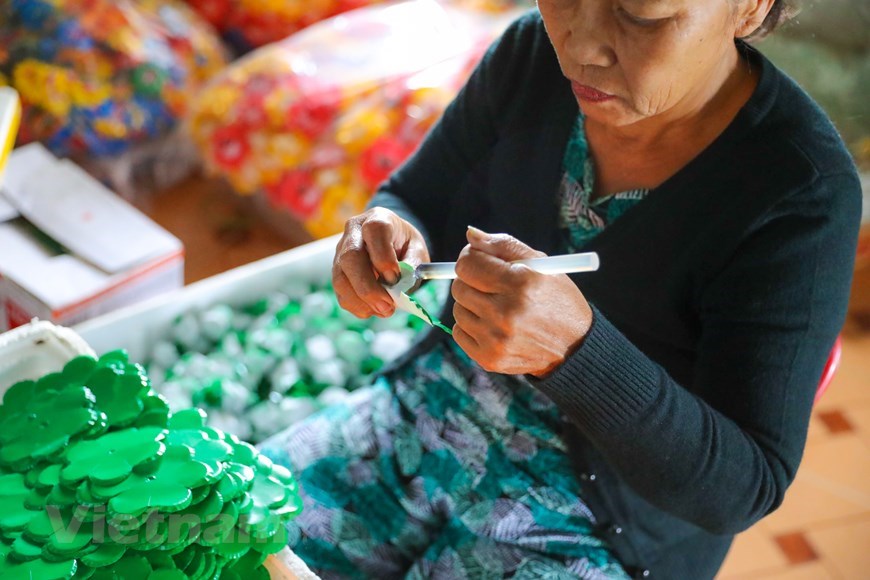
Phan Thi Thanh, an artisan in Thanh Tien craft village, said her family has run the paper flower making craft for a very long time. The family often opens their door for tourists who want to learn about their traditional works and try making the flowers themselves. As Tet (Vietnamese Lunar New Year Festival) approaches, local craftsmen, including Phan Thi Thanh’s family, get busier to ensure an adequate supply of their flowers that do not wither. In addition to economic benefits, Thanh Tien’s villagers wish that even in difficult circumstances, they would be able to preserve, promote and develop the quintessence of their ancestors’ traditional craft of making paper flowers. (Photo: VietnamPlus)
-
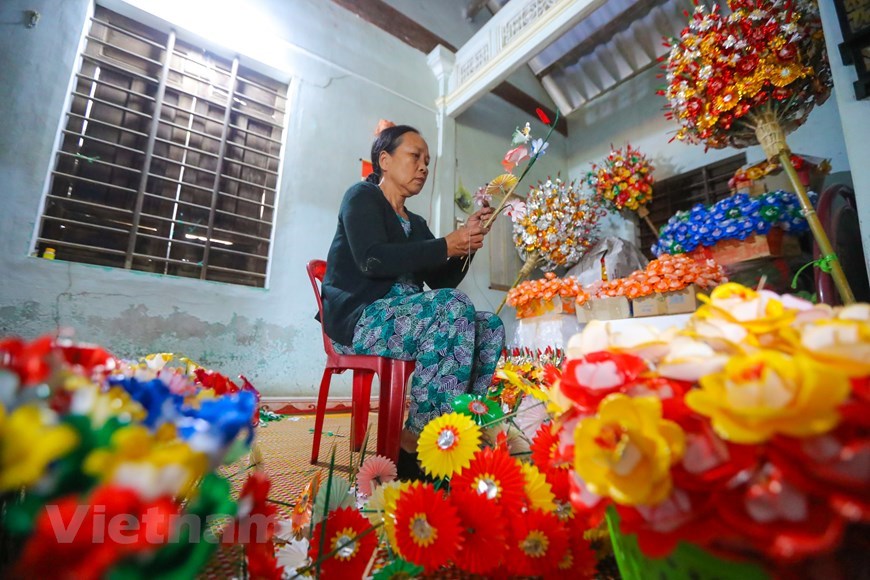
Thanh Tien’s artisan Phan Thi Thanh said that during these last days of a year like this, even though it rains a lot, there are still many tourists coming to visit and experience making flowers at her house. Her family has run the paper flower making craft for a very long time. The family often opens their door for tourists who want to learn about their traditional works and try making the flowers themselves. The visitors are interest in both the village’s ancient architectural features and in the handmade craft experience. Every year, in the run-up to Tet (Vietnamese Lunar New Year Festival), the village seems to be wearing a “new shirt” of vibrant colours from its paper flowers. (Photo: VietnamPlus)
-
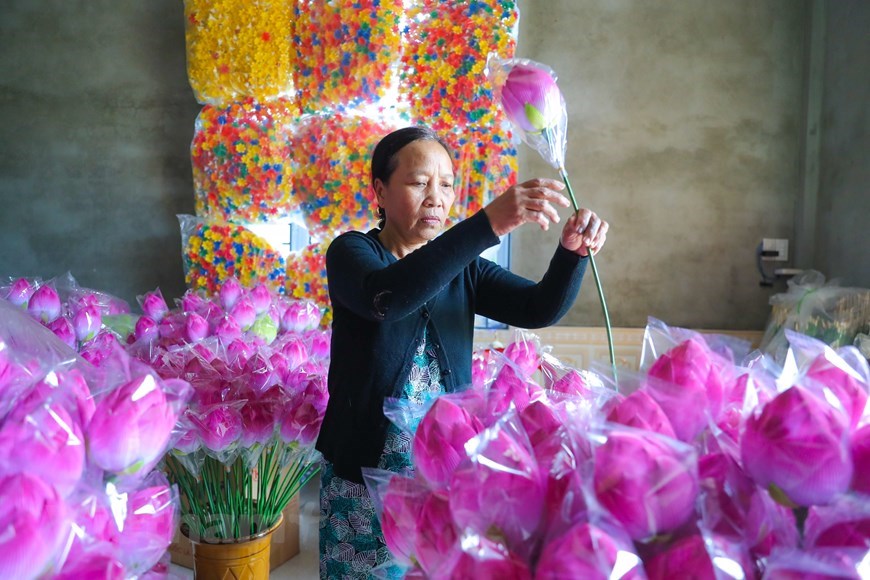
The paper flowers made in the Thanh Tien craft village are now famous as a typical cultural feature of the ancient capital of Hue. They also follow tourists to other regions nationwide such as the capital of Hanoi and the central province of Quang Nam’s Hoi An city or to several places abroad. Going through a painstaking process that requires a lot of time and fine craftsmanship, the paper flowers serve worshipping purposes, and also carry aesthetic and cultural values. “There are two main types of flowers produced in Thanh Tien – those for worshiping purposes, which are only supplied to the market during Tet (Vietnamese Lunar New Year Festival), and paper lotus flowers, which are supplied to the market all year round”, said local artisan Nguyen Hoa. (Photo: VietnamPlus)
-
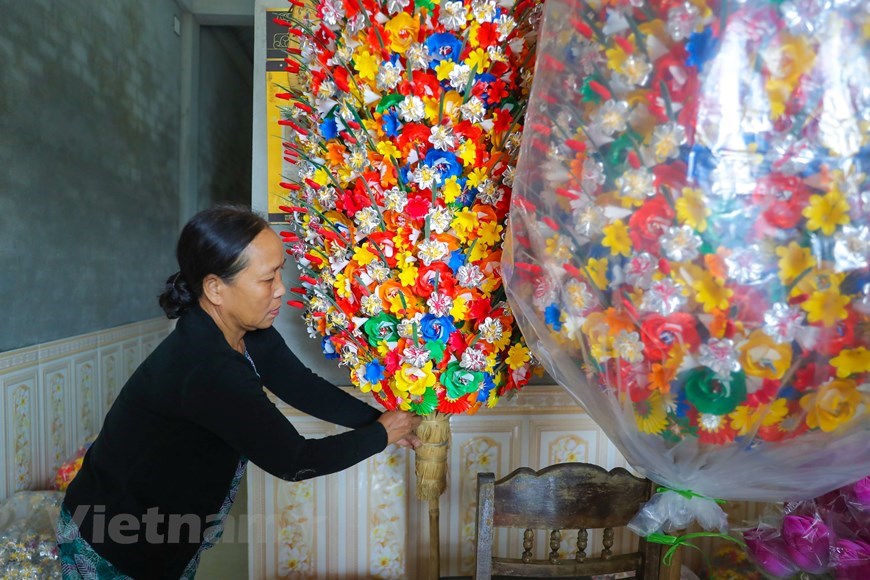
In addition to economic benefits, Thanh Tien’s villagers wish that even in difficult circumstances, they would be able to preserve, promote and develop the quintessence of their ancestors’ traditional craft of making paper flowers. Currently, the demand for worshiping paper flowers has decreased significantly, with flower makers in the 300-year-old village jokingly said that they trade their labour for profits. However, they still want to keep this craft village as a unique cultural trait of Thua Thien Hue province. As a result, the paper flowers made in Thanh Tien village are now famous as a typical cultural feature of the ancient capital of Hue. (Photo: VietnamPlus)
-
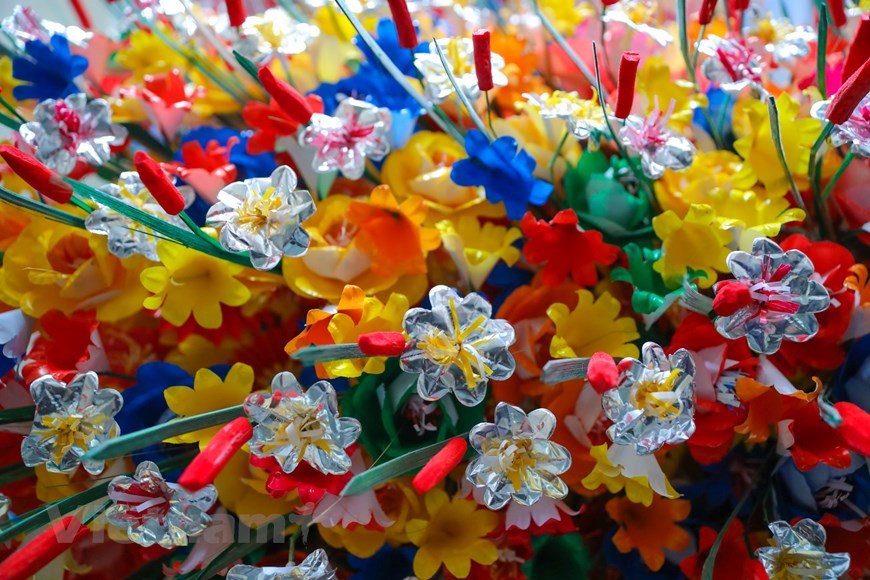
The visitors to Thanh Tien are interest in both the 300-year-old village’s ancient architectural features and in the experience of making paper flowers with their own hands. Lying downstream of the Huong (Perfume) River in Phu Mau commune, Phu Vang district, Thanh Tien paper flower making village is some 7 km away from the ancient imperial city of Hue. It was recognised by Thua Thien – Hue province as a traditional craft village in 2013, with local products displayed at many cultural festivals, including Hue festivals and Ao Dai (Vietnamese traditional long dress) festivals as well as exported to many countries across the world. (Photo: VietnamPlus)
-
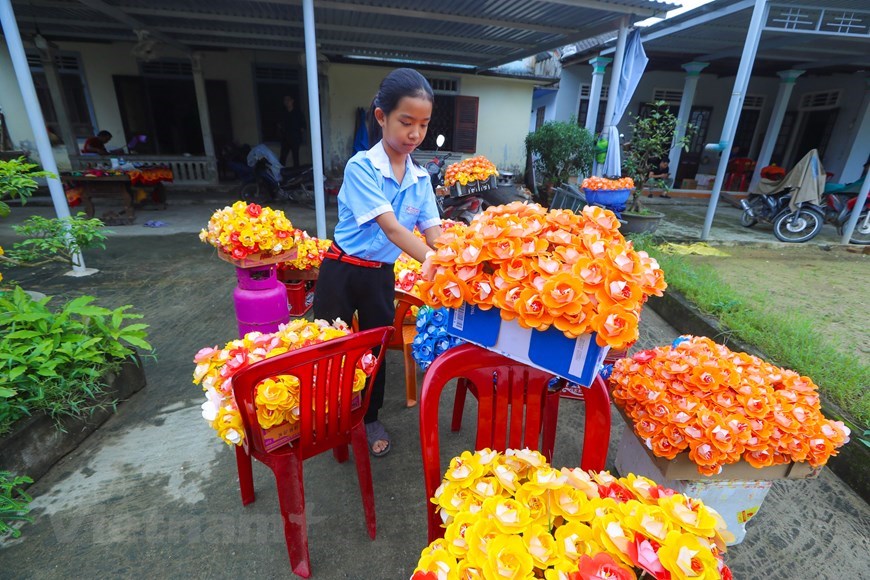
Thanh Tien village was recognised by Thua Thien – Hue province’s authorities as a traditional craft village in 2013. Thanh Tien is situated downstream of the Huong (Perfume) River in Phu Mau commune, Phu Vang district, and is around 7 km away from the ancient imperial city of Hue. The paper flowers made in the craft village are now famous as a typical cultural feature of Hue. They also follow tourists to other regions nationwide such as the capital of Hanoi and the central province of Quang Nam’s Hoi An ancient city or to several places abroad. The products are also displayed at many cultural festivals as well as exported to many countries in the world. (Photo: VietnamPlus)
-
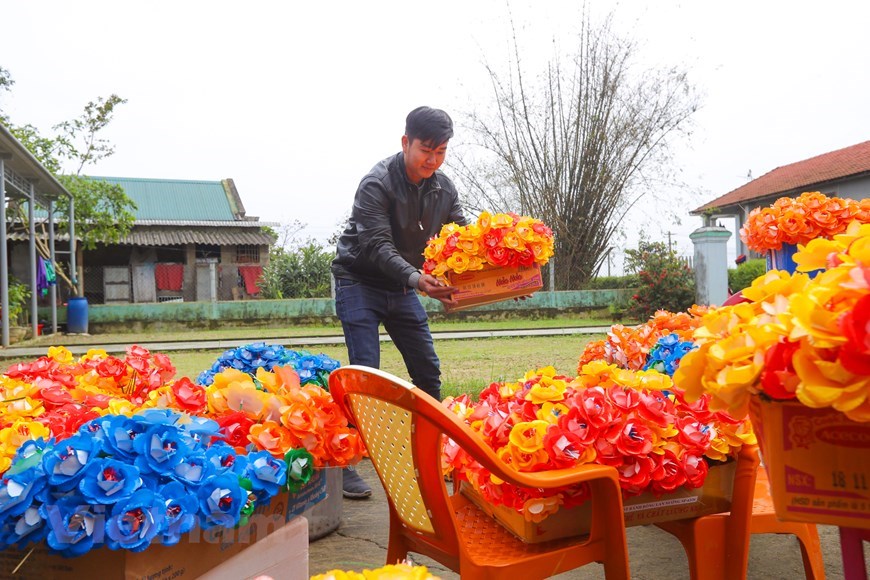
In recent years, Thanh Tien paper flower making village has obtained a position for itself, with local products displayed at many cultural festivals in the country, including Hue festivals and Ao Dai (Vietnamese traditional long dress) festivals, among other events. Its flowers are also exported to many countries across the world. In addition to economic benefits, Thanh Tien’s villagers wish that even in difficult circumstances, they would be able to preserve, promote and develop the quintessence of their ancestors’ traditional craft of making paper flowers. The age old craft has long been practiced as part of the Hue people’s ancestor worship tradition. (Photo: VietnamPlus)
300-year-old craft village makes lifelike paper flowers
Artisans in the central province of Thua Thien-Hue’s 300-years-old Thanh Tien craft village are busy with making paper lotus flowers, as the Lunar New Year Festival approaches.


